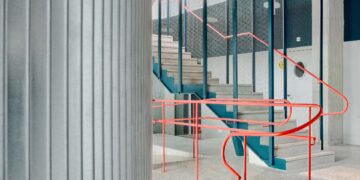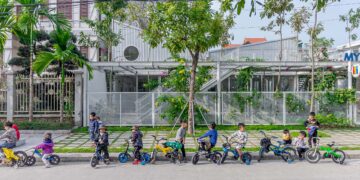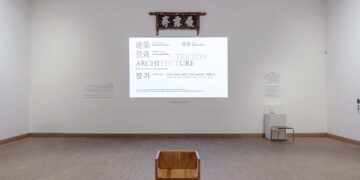An energy efficient house arranged around a wooden core “concatenates” household scenarios
목재 코어로 가족의 일상을 연결하는 에너지 절약형 주택
Ayllón. Paradela. De Andrés Arquitectos | 아일론. 파라델라. 안드레스 아르끼떽또스

Household scenarios
The house, in Madrid, Spain, is designed as a large volume that contains multiple platforms, which are placed as alternated mezzanines in response to the slope of the terrain. These are concatenated in plan and section in a spiral way around a central wooden core – woodcase – which is understood as a large habitable box that contains the server program. This maximizes the freedom and flexibility of served spaces – facilitating the household scenarios.
This organization, free of corridors, allows a flexible use of the different floors. The levels are qualified according to the gradient of privacy established by the scheme itself, supporting the ever-changing rituals of daily life: rest, leisure and work. The intermediate levels, more public and spatially linked to each other, extend towards the garden spaces. The spaces further away from the access become more private, sheltering the main rooms of the house.
구조적 특징
스페인 마드리드에 위치한 ‘우드케이스 주택’은 다층 구조를 품은 단일 건물로 이루어진 집이다. 경사진 대지의 형태에서 착안해 내부에 중층을 차례로 쌓아 올려 내부 공간을 설계했다. 각 중층은 목재 코어를 중심에 두고 나선형으로 평면 및 단면상에서 연결되어 있다. 코어 내부에는 편의 시설을 배치해 전체 공간을 더욱 유연하고 자유롭게 사용할 수 있다.
복도가 없는 독특한 실내 구조를 바탕으로 각 층을 융통성 있게 사용하도록 되어 있다. 프라이버시의 필요 정도에 따라 각 층의 성격을 구분해 쉼과 놀이, 업무 등의 일상이 다채롭게 이루어질 수 있다. 중층은 공적 영역으로서 서로 공간적으로 연결되어 있으며 정원으로까지 확장된다. 진입부와 떨어져 있는 부분에는 침실 같은 개인적 공간을 배치했다.



Context and materiality
Facing a heterogeneous context – a suburban area dominated by single-family homes of different materials, colors and shapes – an abstract approach was taken. The architects designed the house as a large white volume, perforated by generous openings. Towards the urban space, the house appears as a neutral backdrop to the deciduous vegetation that surrounds the plot.
From a material standpoint, neutral and simple finishes have been chosen. The central core around which the whole house is organized – the woodcase – is built in wood and finished with oak plywood boards. It takes a leading role in all the spaces, providing a warming atmosphere to all the interiors of the house.
맥락과 재료
부지는 서로 다른 재료와 색감, 형태로 이루어진 단독주택이 주를 이루는 교외 지역으로, 추상적인 접근 방식이 얼마든지 용인이 될 만한 곳이었다. 건축가가 떠올렸던 이미지는 널찍한 창문으로 개방감을 확보한 커다란 흰색 건물이었다. ‘우드케이스 주택’은 도시 공간과 낙엽수로 둘러싸인 부지 사이에서 서로의 경관을 해치지 않으면서 자연스러운 풍경을 만드는 요소로 자리한다.
재료 면에서 보면 명료하면서도 중성적인 소재를 마감재로 사용했다. 집의 중심에 위치할 뿐 아니라 전체 공간을 주도하는 목재 코어는 오크 나무 합판으로 마감해 따스한 실내 분위기를 연출한다.



Comfort and energy efficiency
From an energy standpoint, the massive nature of the building minimizes energy needs and becomes a “comfort strategy” itself. A thick envelope of reinforced clay walls and solid concrete slabs ensure high thermal inertia, understanding the house itself as a great thermal accumulator. The large openings allow to capture the sun in winter, minimizing the heating demand. In summer, the exterior regulable blinds provide protection from the sun, minimizing the cooling demand.
The deciduous vegetation and the landscaped surroundings to the south, together with the water of the swimming pool to the west, create a small microclimate around the house, which benefits all the rooms thanks to the natural ventilation. Likewise, active strategies based on the use of aerothermal energy as a renewable source, and a floor heating/refreshing system combined with an enthalpy heat recovery system, allowed the architects to reduce energy consumption. A system of photovoltaic solar panels capable of producing 4.5kW of energy completes the system.
안락함과 에너지 효율성
‘우드케이스 주택’은 에너지 효율성과 안락함을 동시에 추구한 집이다. 강화 점토 벽을 두툼하게 두르고 튼튼한 콘크리트 슬래브를 사용해 열관성이 뛰어난 이 집은 건물 자체가 거대한 축열기 역할을 하는 구조다. 겨울에는 널찍한 창으로 햇살이 넉넉히 들어와 난방을 많이 할 필요가 없다. 여름에는 외부에 설치한 접이식 블라인드가 뜨거운 햇볕을 가려주어 냉방을 최소화할 수 있다.
부지의 남쪽에 자리한 낙엽수와 조경은 서쪽에 있는 수영장과 함께 이 집만의 기후 환경을 조성하는 요소이자 집 안 모든 공간에서 이 자연 환기 장치의 혜택을 누릴 수 있다. 대기열을 재활용하는 전략과 열 보존 시스템을 결합한 난방 및 환기 시스템을 적용해 에너지 소비량을 줄이는 것에서 그치지 않고 4.5킬로와트를 생산하는 태양광 패널을 설치해 에너지 절약형 주택의 완결판을 보여주고 있다.




Project: Woodcase House / Location: Calle Antonio Cavero 59, Madrid, Spain / Architect: Ayllón. Paradela. De Andrés Arquitectos / Built area: 244.5m² / Useful area: 203.5m² / Design: 2019 / Completion: 2021 / Photograph: ©Miguel Fernández-Galiano Rodriguez




































